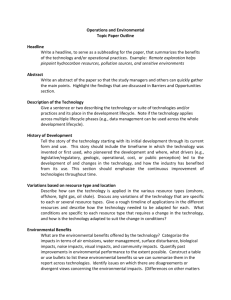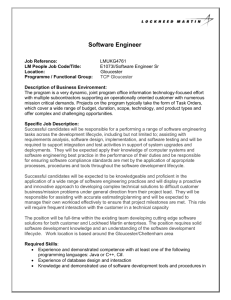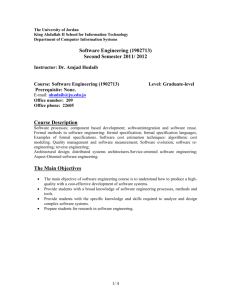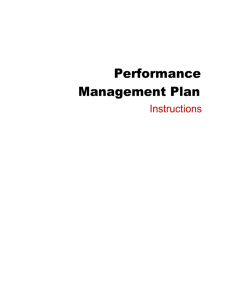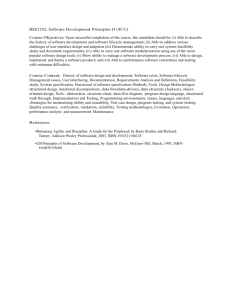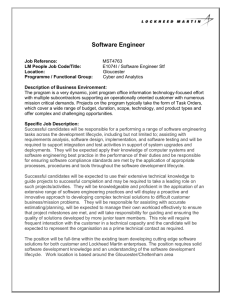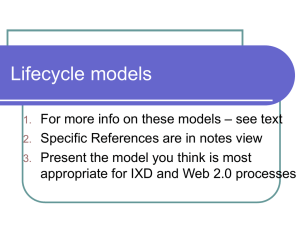U2_business life cycle_note
advertisement
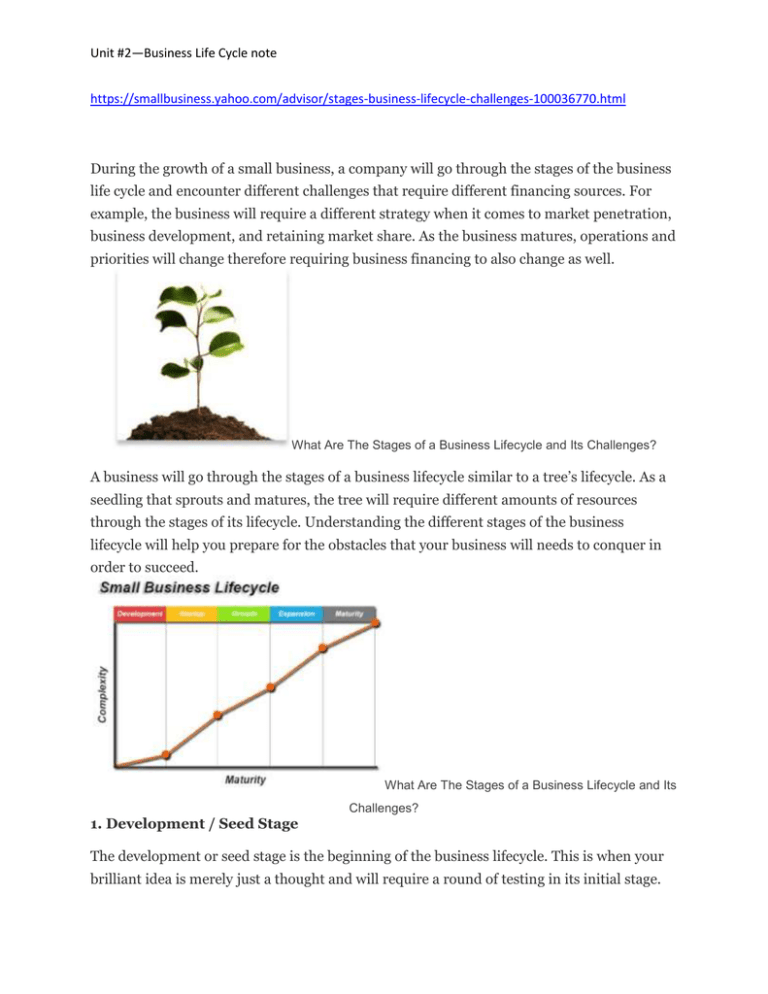
Unit #2—Business Life Cycle note https://smallbusiness.yahoo.com/advisor/stages-business-lifecycle-challenges-100036770.html During the growth of a small business, a company will go through the stages of the business life cycle and encounter different challenges that require different financing sources. For example, the business will require a different strategy when it comes to market penetration, business development, and retaining market share. As the business matures, operations and priorities will change therefore requiring business financing to also change as well. What Are The Stages of a Business Lifecycle and Its Challenges? A business will go through the stages of a business lifecycle similar to a tree’s lifecycle. As a seedling that sprouts and matures, the tree will require different amounts of resources through the stages of its lifecycle. Understanding the different stages of the business lifecycle will help you prepare for the obstacles that your business will needs to conquer in order to succeed. What Are The Stages of a Business Lifecycle and Its Challenges? 1. Development / Seed Stage The development or seed stage is the beginning of the business lifecycle. This is when your brilliant idea is merely just a thought and will require a round of testing in its initial stage. Unit #2—Business Life Cycle note In testing your business idea, you may conduct research regarding the industry, gather feedbacks from your friends, family, colleagues, or other industry specialists. This is when you are determining whether the business idea that you had is worth pursuing and if so it will be the birth of your new business. Challenges Business Idea Profitability Market Acceptance Establishing Business Structure Accounting Management 2. Startup Stage You’ve decided that your business idea is worth pursuing and have now made your business entity legal. In this stage, you’ve finished developing the products or services that your business has to offer and will begin marketing and selling. During this stage, you will be tweaking your products or services according to the initial feedback from your first paying customers and market demand. You will need to learn and adjust your business model to ensure profitability and that it meets your customer’s expectations. By adjusting your business model, you’ll be able to set your business on the right track. Challenges Managing Cash Reserves Managing Sales Expectations Accounting Management Establishing Customer Base Establishing Market Presence 3. Growth / Survival Stage Your business has endured through the initial stages of the business lifecycle and is currently in its growth or survival stage. The business is consistently generating revenue and adding new customers. These recurring revenue will help pay for your operating expenses and open up new business opportunities. Currently, your business could be operating at a net loss or maintaining a healthy profit, but there could be some competition. This is also when you need to fine tune your business model and implement proven methodologies, sales model, marketing model, and operations model before expanding your venture for the mass market. Challenges Dealing with Increasing Revenue Unit #2—Business Life Cycle note Dealing with Increasing Customers Accounting Management Effective Management Market Competition 4. Expansion / Rapid Growth Stage Your business has been a thriving company and established its presence in the industry. You have now reached the stage in which your business will expand and spread its roots into new markets and distribution channels. In order to start capitalizing on the success of your business, you will need to capture a larger market share and find new revenue. Therefore your business will experience a rapid growth in revenue and cash flow. The rapid growth stage takes advantage from the proven sales model, marketing model, and operations model set forth from your growth/survival stage. Challenges Increasing Market Competition Accounting Management Moving into New Markets Adding New Products/Services Expanding Existing Business 5. Maturity Stage After a successful expansion, your business is on top of its industry and has matured. At the final stage of the business lifecycle, your business has a dominating presence in its market. Your business could still be growing but not at the substantial rate as you’ve previous experienced. Your current option is to decide to take a step back towards the expansion stage or to think of a possible exit strategy. Challenges Increasing Market Competition Accounting Management Moving into New Markets Adding New Products/Services Expanding Existing Business Exit Strategy Every stage of the business lifecycle brings new or pre-existing challenges. Solutions that may have worked for one stage may not work in another stage, which is why you should always adjust your business plan and operations accordingly. Unit #2—Business Life Cycle note At each stage, your business will rely on a financial source to help overcome the challenges your business faces. This is especially important to have an accounting management software in place so that you will have an accurate reflection of your current business finances. Having an accounting software in place will help you understand where your business is on the current business lifecycle and the details will allow you foresee upcoming challenges and to make better business decisions. This article originally appeared on Servora Blog and has been republished with permission. This article was syndicated from Business 2 Community: What Are The Stages of a Business Lifecycle and Its Challenges? Unit #2—Business Life Cycle note http://www.addisonandco.co.uk/the-7-stages-of-business/ Where are you in the 7-stage cycle? Every business goes through a number of changes in the course of its lifetime and it makes sense for businesses to understand exactly where they are in the cycle so they can prepare for the next stage. In this brief report, you’ll learn what upcoming challenges, focuses and financing sources you will need to succeed at every stage of your business’ life. 1. 2. 3. 4. 5. 6. 7. Seed Stage Start-Up Stage Growth Stage Established Stage Expansion Stage Decline Stage Exit Stage The Seven Stages of Business Life 1. Seed Stage The seed stage of your business life cycle is when your business is just a thought or an idea. This is the very conception or birth of a new business. Challenge: Most seed stage companies will have to overcome the challenge of market acceptance and pursue one niche opportunity. Do not spread money and time resources too thin. Focus: At this stage of the business the focus is on matching the business opportunity with your skills, experience and passions. Other focal points include: deciding on a business ownership structure, finding professional advisors, and business planning. Money Sources: Early in the business life cycle with no proven market or customers the business will rely on cash from owners, friends and family. Other potential sources include suppliers, customers and government grants. 2. Start-Up Stage Your business is born and now exists legally. Products or services are in production and you have your first customers. Challenge: If your business is in the start-up life cycle stage, it is likely you have over under estimated money needs and the time to market. The main challenge is not to burn through what little cash you have. You need to learn what profitable needs your clients have and do a reality check to see if your business is on the right track. Unit #2—Business Life Cycle note Focus: Start-ups need to establish a customer base and market presence along with tracking and conserving cash flow. Money Sources: Owner, friends, family, suppliers, customers, or grants. 3. Growth Stage Your business has made it through the toddler years and is now a child. Revenues and customers are increasing with many new opportunities and issues. Profits are strong, but competition is surfacing. Challenge: The biggest challenge growth companies face is dealing with the constant range of issues bidding for more time and money. Effective management is required and a possible new business plan. Learn how to train and delegate to conquer this stage of development. Focus: Growth life cycle businesses are focused on running the business in a more formal fashion to deal with the increased sales and customers. Better accounting and management systems will have to be set-up. New employees will have to be hired to deal with the influx of business. Money Sources: Banks, profits, partnerships, grants and leasing options. 4. Established Stage Your business has now matured into a thriving company with a place in the market and loyal customers. Sales growth is not explosive but manageable. Business life has become more routine. Challenge: It is far too easy to rest on your laurels during this life stage. You have worked hard and have earned a rest but the marketplace is relentless and competitive. Stay focused on the bigger picture. Issues like the economy, competitors or changing customer tastes can quickly end all you have worked for. Focus: An established life cycle company will be focused on improvement and productivity. To compete in an established market, you will require better business practices along with automation and outsourcing to improve productivity. Money Sources: Profits, banks, investors and government. 5. Expansion Stage This life cycle is characterised by a new period of growth into new markets and distribution channels. This stage is often the choice of the small business owner to gain a larger market share and find new revenue and profit channels. Challenge: Moving into new markets requires the planning and research of a seed or startup stage business. Focus should be on businesses that complement your existing experience and capabilities. Moving into unrelated businesses can be disastrous. Focus: Add new products or services to existing markets or expand existing business into new markets and customer types. Money Sources: Joint ventures, banks, licensing, new investors and partners. Unit #2—Business Life Cycle note 6. Decline Stage Changes in the economy, society, or market conditions can decrease sales and profits. This may quickly end many small companies. Challenge: Businesses in the decline stage of the life cycle will be challenged with dropping sales, profits, and negative cash flow. The biggest issue is how long the business can support a negative cash flow. Ask is it time to move on to the final life cycle stage…exit. Focus: Search for new opportunities and business ventures. Cutting costs and finding ways to sustain cash flow are vital for the declining stage. Money Sources: Suppliers, customers, owners. 7. Exit Stage This is the big opportunity for your business to cash in on all the effort and years of hard work. Or it can mean shutting down the business. Challenge: Selling a business requires your realistic valuation. It may have been years of hard work to build the company, but what is its real value in the current market place? If you decide to close your business, the challenge is to deal with the financial and psychological aspects of a business loss. Focus: Get a proper valuation of your company. Look at your business operations, management and competitive barriers to make the company worth more to the buyer. Set up a business transition plan. Money Sources: Find a business valuation partner. Consult with your accountant and financial advisors for the best tax strategy to sell or close down. Each stage of the business life cycle may not occur in chronological order. Some businesses will be “built to flip”; quickly going from start-up to exit. Others will choose to avoid expansion and stay in the established stage. Whether your business is a glowing success or a dismal failure depends on your ability to adapt to its changing life cycles. What you focus on and overcome today will change in the future. Understanding where your business fits on the life cycle will help you foresee upcoming challenges and make the best business decisions.

